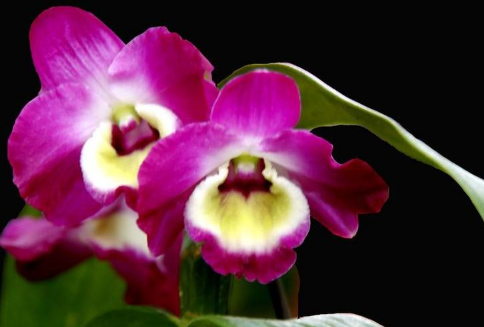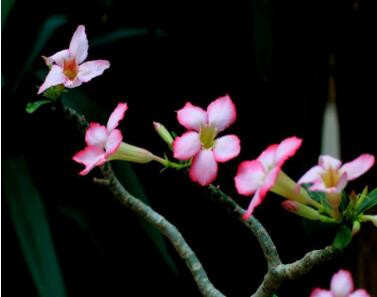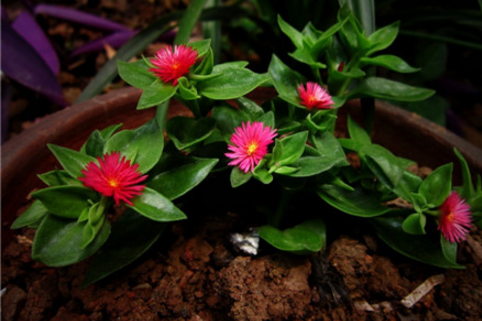What if the leaves of Dendrobium turn yellow?
1. Environmental effect
Dendrobium is suitable for growing in a semi-overcast environment. If Dendrobium is planted in a dry environment for a long time, the leaves will easily turn yellow when exposed to strong light.

two。 Seasonal variation
The weather will affect the color change of the leaves of Dendrobium. When there is a seasonal change, it is necessary to increase the amount of organic fertilizer to help plants improve their resistance.
3. Control moisture
Potted Dendrobium should not be watered too much, otherwise the roots will rot, so the amount of water should be controlled in time; if the temperature is high, it is easy to make the soil dry and need timely watering to keep moist.
Now we all know what to do with Dendrobium after flowering, so we should cultivate Dendrobium well and not just watch its beautiful flowers.
Analysis on the cause of yellowing of Dendrobium leaves
Dendrobium is dry and afraid of stagnant water, especially when the new buds begin to germinate to the formation of new roots. But too wet, such as low temperature, it is easy to cause decay. When the weather is fine, dry and hot, in addition to watering, it is necessary to spray more water to the ground to maintain a high air humidity. What if the leaves of Dendrobium turn yellow? The following wed114 wedding network editor brings you the details of the causes of the yellowing of Dendrobium leaves.
What if the leaves of Dendrobium are yellow?
We know the environment in which Dendrobium is suitable to grow. Dendrobium likes humid and semi-shady environment, especially the wild Dendrobium will have higher requirements on the environment.
Method one
Only in a humid and semi-overcast environment will it be beneficial to the respiration of the air root of Dendrobium. If Dendrobium is always planted in a high temperature, dry, direct sun environment, the leaves will easily turn yellow, so the choice of environment is very important.
Method two
The influence of weather, seasonal change, will affect the color change of Dendrobium leaves, in the seasonal change should pay attention to the increase of organic fertilizer. Ensure the moisture level of the leaves and help the plant improve its resistance.
Method three
When the leaves of Dendrobium turn yellow, you must pay attention to that if it is not treated in time, it will cause the whole plant of Dendrobium to dry up, so it should be reasonable and suitable to gradually solve the main problem of yellowing of Dendrobium leaves.
Growth habits of Dendrobium
Often grow on tree trunks or rocks at 480-1700 meters above sea level. Like warmth. Moist and semi-overcast environment, not resistant to cold. The suitable temperature for growth is 18: 30 ℃, the suitable growth period is 16: 21 ℃, the dormant period is 16: 18 ℃, the night temperature is 10: 13 ℃, and the temperature difference is 10: 15 ℃. The daytime temperature exceeding 30 ℃ had little effect on the growth of Dendrobium, and the winter temperature was not lower than 10 ℃. Seedlings are susceptible to freezing below 10 ℃.
Dendrobium is dry and afraid of stagnant water, especially when the new buds begin to germinate to the formation of new roots. But too wet, such as low temperature, it is easy to cause decay. When the weather is fine, dry and hot, in addition to watering, it is necessary to spray more water to the ground to maintain a high air humidity. Evergreen Dendrobium can maintain sufficient moisture in winter, but deciduous Dendrobium can be properly dried to maintain high air humidity.
Dendrobium wild forest, but the cultivation is still more like light, 50% shading in summer and autumn, 30% shading in winter and spring is appropriate. If the light is too strong, the stem will be swollen and yellow, and the leaves will be yellowish green. But the sunshine is sufficient, the autumn flowering is good, and the flowering quantity is large.
The soil should use well-drained and breathable broken fern root, water moss, charcoal chips, broken tiles, perlite and so on, mainly broken fern root and water moss.
Dendrobium is the largest genus of Orchidaceae, including about 1500 species of plants, mainly distributed in tropical Asia and Pacific islands. There are about 63 species of Dendrobium in China and 39 species of Dendrobium for medicinal purposes. Domestic Dendrobium is distributed in the south of Qinling Mountains and Huaihe River. in terms of latitude, most species are concentrated between 15 °30 °N and 25 °12'N, and the northward species gradually decrease, and the northernmost boundary does not exceed 34 °24'N. From a vertical point of view, it is distributed at an altitude of 100 to 3000 meters above sea level. Dendrobium is a group developing from the center of tropical Southeast Asia to subtropical climatic conditions. Yunnan, Guangxi, Guangdong, Guizhou and Taiwan are the distribution centers of domestic plants.
The solution to the yellowing of Dendrobium leaves
The solution to the yellowing of Dendrobium leaves
We know the environment in which Dendrobium is suitable to grow. Dendrobium likes humid and semi-shady environment, especially the wild Dendrobium will have higher requirements on the environment.
Method one
Only in a humid and semi-overcast environment will it be beneficial to the respiration of the air root of Dendrobium. If Dendrobium is always planted in a high temperature, dry, direct sun environment, the leaves will easily turn yellow, so the choice of environment is very important.
Method two
The influence of weather, seasonal change, will affect the color change of Dendrobium leaves, in the seasonal change should pay attention to the increase of organic fertilizer. Ensure the moisture level of the leaves and help the plant improve its resistance.
Method three
When the leaves of Dendrobium turn yellow, you must pay attention to that if it is not treated in time, it will cause the whole plant of Dendrobium to dry up, so the main problem of yellowing of Dendrobium leaves should be solved gradually.
- Prev

Second, matters needing attention when solving the problem of yellowing of its leaves
1. Sometimes, the yellowing of the leaves of desert roses is a normal phenomenon. For example, desert roses have just moved to a new environment and are not very adaptable. In the face of this situation, don't make a fuss. In addition to the points mentioned earlier, the yellowing of desert rose leaves may also be due to the application of too much fertilizer to it.
- Next

Cuttage of Peony Cymbidium
The preparation of cutting branches in a pot of mature and good growth of peony Cymbidium mother plant cut about 10 cm of branches, of course, length is not a key factor, depending on the specific situation, this will not affect the success rate of cutting. The preparation of cutting soil Peony Cymbidium is a kind of strong ability to adapt to the environment.
Related
- Fuxing push coffee new agricultural production and marketing class: lack of small-scale processing plants
- Jujube rice field leisure farm deep ploughing Yilan for five years to create a space for organic food and play
- Nongyu Farm-A trial of organic papaya for brave women with advanced technology
- Four points for attention in the prevention and control of diseases and insect pests of edible fungi
- How to add nutrient solution to Edible Fungi
- Is there any good way to control edible fungus mites?
- Open Inoculation Technology of Edible Fungi
- Is there any clever way to use fertilizer for edible fungus in winter?
- What agents are used to kill the pathogens of edible fungi in the mushroom shed?
- Rapid drying of Edible Fungi

